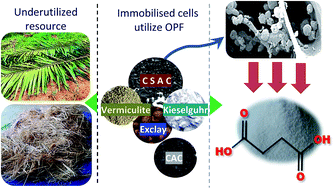Potential use of coconut shell activated carbon as an immobilisation carrier for high conversion of succinic acid from oil palm frond hydrolysate
Abstract
Economical production of succinic acid via bacterial immobilisation offers significant potential to meet the demands of an ever increasing global population. However, insufficient research has been devoted to converting lignocellulosic materials into succinic acid via bacterial immobilisation. In the present work, bacterial immobilisation onto porous supports was investigated using wild-type Actinobacillus succinogenes 130Z. The use of a cost-effective and robust coconut shell activated carbon (CSAC) carrier was compared with kieselguhr, exclay, coal activated carbon, and vermiculite. It was found that the electrokinetic potential exhibited by exclay was the lowest (−17 mV), followed by CSAC (−16 mV). Maximum succinic acid conversion from oil palm frond (OPF) bagasse hydrolysate was reported with A. succinogenes immobilised on CSAC, with 23% improvement over the use of free cells. The highest succinic acid production yielded 40.2 g L−1 in batch-mode cultivation. Repeated batch fermentation was performed using CSAC for 5 cycles over 180 h, attaining an average succinic acid concentration of 44.1 g L−1, productivity of 1.3 g L−1 h−1 and yield of 0.9 g g−1 of OPF bagasse hydrolysate for all batches. Collectively, the results highlight the critical role of coconut shell as a renewable source of a carbon carrier for repeated biosynthesis of succinic acid.



 Please wait while we load your content...
Please wait while we load your content...